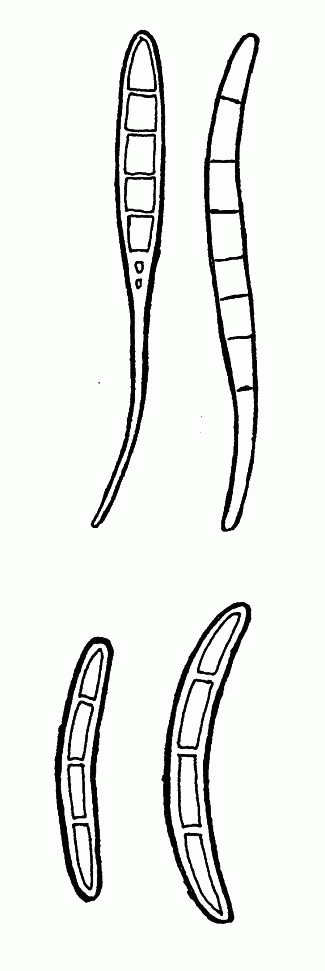Collema nigrescens (Hudson) DC.
Double-bubble tarpaper
Collemataceae
Introduction to the Lichens
Double-bubble tarpaper
Collemataceae
Introduction to the Lichens
Map
Distribution of Collema nigrescens unavailable
Species Information
General:
Common Name: The Tarpaper Lichens. Stresses the blackish nonstratified medulla that becomes somewhat swollen, translucent and jellylike when moistened.
Minute to occasionally large nonstratified foliose lichens (gelatinous when wet), lacking true cortex, (except cortex present on apothecial margin: see below) isidiate or not, lobes closely appressed to semi-erect, 0.5–10 (–15) mm wide, thin to thick. Upper surface dark olive brownish or blackish (ours), dull. Lower surface dark, rhizines absent or rarely present. Medulla absent. Photobiont blue-green.
Apothecia located over upper surface or marginal, with thalline margin, disc reddish brown; spores 2- to multicelled, ellipsoid to needle-shaped/acicular, (4–) 8 per ascus. Over bark, earth and rock, usually base-rich.
Notes: Collema is a taxonomically difficult genus comprising about 80 species, of which 35 are known to occur in North America and 20 in B.C. Chemistry is of no diagnostic value in this genus. Two keys are provided. The first key emphasizes macroscopic vegetative characters, though spore characters have been incorporated in some places. The second key, to nonisidiate species, stresses spore characters and is more technical.
Species description:
Lobe margins hairless; isidia, if present, also lacking hairs AND
Thallus foliose or, if somewhat fruticose, then lobes proportionally much shorter and broader; habitat and distribution various AND
Lobes brownish to olive-brownish or blackish, but never jet black above and below; rarely pruinose; habit, substrate and distribution various AND
Isidia absent or, if present, then either essentially globular throughout or becoming cylindrical or branched/coralloid at maturity; scalelike lobules absent (or sparse in some specimens of C. furfuraceum) over upper surface AND
Lobe thickness uniform throughout, lobe tips scarcely (if at all) more swollen than central portions of thallus; upper surface sharply and finely wrinkled or not; central portions of thallus dull (except occasionally shiny in C. nigrescens) AND
Upper surface lacking isidia (Note: nonconstricted, isidia-like lobules may occur along margins in some species) AND
Over trees; upper surface usually somewhat blistered/pustulate AND
Spores more than 4-celled, usually more than 40 m long
Comments:
The B.C. material may not be taxonomically homogeneous; the inland specimen is characterized by rather small spores and may represent a separate species. Collema curtisporum Degel. has been reported for Washington (Degelius 1974) and may be found in British Columbia. It has short, 4-celled spores (averaging to less than 40 m long), differing from the spores of C. nigrescens, which are 6- to 13-celled and more than 40 m long.
Source: Lichens of British Columbia
Illustration

If more than one illustration is available for a species (e.g., separate illustrations were provided for two subspecies) then links to the separate images will be provided below. Note that individual subspecies or varietal illustrations are not always available.
Illustration By: Trevor Goward
Habitat and Range
Habitat: Infrequent over trees, especially deciduous, in sheltered coast forests, also rare in boreal localitiesWorld Distribution: circumpolar, S to CA.
Source: Lichens of British Columbia